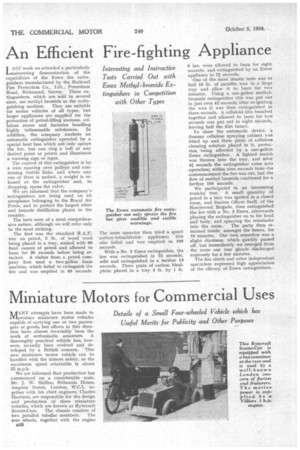An Efficient Fire-fighting Appliance
Page 46

If you've noticed an error in this article please click here to report it so we can fix it.
Interesting and Instructive Tests Carried Out with Essex Methyl-bromide Extinguishers in Competition with Other Types
LAST week we attended a particularly 1-finteresting demonstration of the capabilities of the Essex fire extinguishers manufactured by the National Fire Protection Co., Ltd., Petersham Road, Richmond, Surrey. These extinguishers, which are sold in several sizes, use methyl bromide as the extinguishing medium. They are suitable for motor vehicles of all types, but larger appliances are supplied for the protection of petrol-filling stations, cellulose stores and factories handling highly inflammable substances. In addition, the company markets an automatic extinguisher operated by a special heat fuse which not only sprays the fire, but can ring a bell at any desired point or points and illuminate a warning sign or signs.
The control of this extinguisher is by a wire running over pulleys and containing fusible links, and where any one of these is melted, a weight is released at the extinguisher and, in dropping, opens the valve.
We are informed that the company's extinguishers are being used on all aeroplanes belonging to the Royal Air Force, and to protect the largest ether and benzole distillation plants in the country.
The tests were of a most comprehensive nature, although we will refer only to the most striking.
The first was the standard R.A.F. test on petrol, 2 lb. of wood wool being placed in a tray, soaked with 60 fluid ounces of petrol and allowed to burn for 20 seconds before being attacked. A visitor from a petrol company first used a two-gallon foam machine, which failed to extinguish the fire and was emptied in 60 seconds. The same operator then tried a quart carbon-tetrachloride appliance; this also failed and was emptied in 100 seconds.
With a No. 3 Essex extinguisher, the fire was extinguished in 22 seconds, relit and extinguished in a further 13 seconds. Three pints of carbon bisulphide placed in a tray 2 ft. by 1 ft. 6 ins, were allowed to burn for eight seconds, and extinguished by an Essex appliance in 71 seconds. One of the most drastic tests was to boil 10 lb. of paraffin wax in a large tray and allow it to burn for two minutes. Using a one-gallon methylbromide extinguisher this was put out in just over 42 seconds; after re-igniting the wax it was then extinguished in three seconds. A celluloid film bunched together and allowed to burn for two seconds was put out in eight seconds, leaving half the film intact.
To show the automatic device, a dummy cellulose spraying cabinet was fitted up and three pints of cellulose cleaning solution placed in it, protection being afforded by a one-gallon Essex extinguisher. A lighted match was thrown into the tray, and after 4-} seconds the extinguisher came into operation; within nine seconds from tha commencement the fire was out, but the flow of methyl bromide continued for a further 105 seconds.
We participated in an interesting toxicity test. A small quantity of petrol in a tray was ignited in a closed room, and Station Officer Snell, of the Northwood Brigade, then extinguished the fire with a No. 3 Essex, afterwards playing the extinguisher on to his head and body, and spraying the remainder into the room. The party then remained inside, amongst the fumes, for 10 minutes. Our own sensation was a slight dizziness, which quickly passed off, but immediately we emerged from the room our tear glands discharged copiously for a few minutes.
The fire chiefs and other independent spectators expressed high appreciation of the efficacy of Essex extinguishers.




































































































